Refraction
Introduction
⇒ Waves change speed when they travel from one medium to another
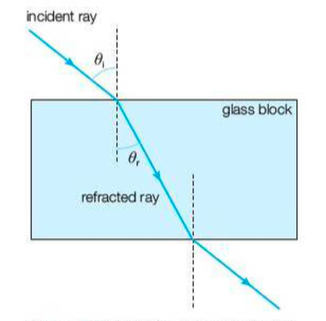
⇒ When light travels at any angle other than the normal, the change in speed will cause a change in direction (i.e. refraction)
⇒ All waves can refraction (light, sound, seismic, etc.)
⇒ The frequency does not change when it travels from one medium to another, but the wavelength does
- When light travels from air into some other medium (e.g. water, glass, etc.), the wave will slow down and the wave;ength will shorten
- Waves change direction towards the normal when they slow down entering a medium, and away from the normal as they speed up

⇒ You can see light entering three different mediums here, with the same angle of incidence (i.e.e angle between incident ray and normal)
⇒ The light changes direction least when entering water but the most when entering the diamond (because the light travels slowest in the diamond) - so diamond is said to have a higher refractive index
Refractive index
⇒ The refractive index (n), is the ratio of the wave's speed between two materials
⇒ A refractive index is calculated using the following:
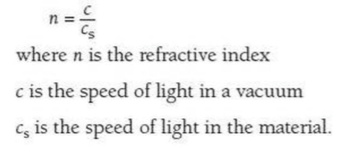
⇒ Because the speed of light in a vacuum is almost exactly the same as the speed of light in air, we can reach two useful and accurate approximations:
- The refractive index of air is approximately equal to 1
- The refractive index of a material is approximately the speed of light in air divided by the speed of light in the material
⇒ The refractive index of glass is about 1.5, which means the speed of light in air is about 1.5 times faster than it is in glass
⇒ When light travels from one material to another (other than air) we define the relative refractive index as:

⇒ If you already know the refractive index of a material in relation to light (such as glass, which has a refractive index of 1.5), we can calculate the refractive index when light passes from one material (not air) to another material (not air) by dividing the two refractive indexes together:
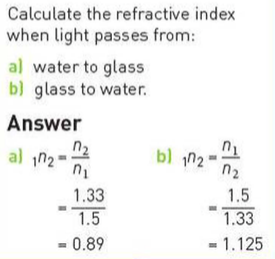
⇒ As you can see, the refractive index travelling from water to glass is the reciprocal of the refractive index when light travels from glass to water
Law of refraction
⇒ The following ratio is constant for all materials:
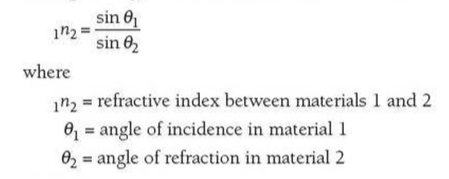
⇒ In other words, Snell's law gives the relationship between angles of incidence and refraction for a wave when it enters into a new medium
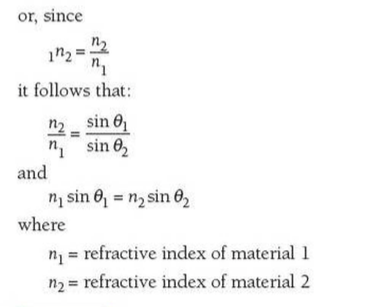
Total Internal Reflection
⇒ Total internal reflection is the complete reflection of waves back inside a medium at a boundary with a second material that has a higher refractive index than its surroundings
- E.g. Light can be totally internally reflected off the inside of a glass block which is surrounded by air. Light travels more slowly in glass than air (so air has a lower refractive index than glass)
⇒ When light passes from glass to air, the angle of refraction will be greater than the angle of incidence
⇒ When the angle of refraction reaches 90 degrees (i.e. the critical angle), the light will travel along the boundary
⇒ When the angle of refraction reaches 90 degrees all light is refracted internally
- At this point the refracted angle is 90 degrees and sinθ = 1
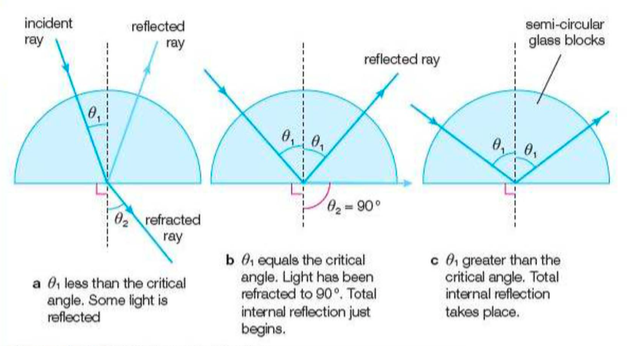
⇒ We can predict the critical angle (i.e the angle of refraction for which the angle of incidence equals 90 degrees) using Snell's law... so long as we know the refractive index of the material the light is travelling in (N1) and the refractive index of the material at the boundary (N2):

Optical Fibres
⇒ Optical fibres are thin glass (or plastic) fibres that transmit light or infrared radiation
⇒ The waves travel through the fibres but are trapped inside by repeated total internal reflection
- In other words, each reflection has an angle of incidence larger than the critical angle
- This critical angle will depend on the ratio between the optical fibre's refractive index and the refractive index of its coating (i.e. cladding) (as we have seen in the notes above on total internal reflection)
⇒ A step index optical fibre is an optical fibre with a uniform refractive index in the core and a smaller uniform refractive index for the cladding
- By choosing certain materials for the opitcal fibre's core and cladding, only certain wavelengths of light/infrared radiation can travel through it by total internal reflection

Material and Modal Dispersion
⇒ A spectrum seen using a prism is caused by dispersion
⇒ Different colours of light travelling through the glass slow down by different amounts
⇒ The refractive index varies with wavelength
⇒ Something similar happens with optical fibres: as signal travels down it, it disperses:
- Material dispersion - this occurs because the refractive index of the optical fibre varies with frequency. Different wavelengths of light travel at different speeds, causing a sharp pulse to spread into a broad signal (i.e. pulse broadening). This limits the maximum frequency of pulses and therefore the available bandwith
- Modal dispersion - this occurs when the rays inside an optical fibe take slightly different paths. If the rays take a longer path they take a longer time to travel through the fibre and the duration of the pulse increases and broadens. For communications, monomode fibres are used to reduce this (i.e.e they have a very narrow core so keep the light confined to a single path)

Absorption
⇒ Some wavelengths of light are absorbed by the optical fibre in which it travels, so the signal strength falls
⇒ It is important to use an optical fibre which has a low level of absorption at the wavelength to send signals
⇒ It may also be necessary to amplify the signal at some point if the signal travels long distances
Extra
⇒ Also see our notes on: